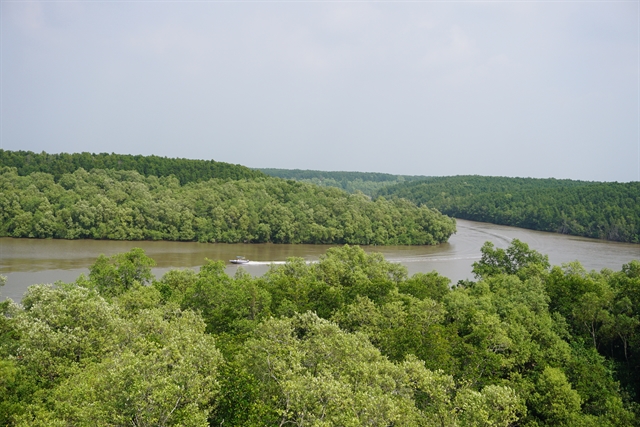
A view of mangroves from 26 metre-high tower at Vàm Sát Ecological Park. — VNS Photo Thu Hằng
Thu Hằng
Noted for its vast mangrove forests, pure air and wildlife sanctuaries, the coastal district of Cần Giờ and its Mangrove Biosphere Reserve is a perfect weekend break from the frenzied activity of the country's big cities.
Located 50km southeast of the HCM City centre, the Cần Giờ wetlands can be visited easily by speedboat, car, motorbike or bus.
Regarded as the “green lung” of the city, the area is home to more than 33,900 hectares of mangroves, one of the most extensive rehabilitated mangrove forests in the world.
In 2000 UNESCO designated Cần Giờ as the first Mangrove Biosphere Reserve in Việt Nam.
With a coastal line of 23km and a river network stretching 22,000 hectares, Cần Giờ has perfect conditions for aquaculture and agriculture as well as eco-tourism and sea tourism.
Eco-tourism
Often referred to as the "kingdom of salt", Thiềng Liềng Island in Cần Giờ District’s Thạnh An Commune has been transformed from an isolated place without electricity and limited living conditions to a new eco-tourism site.
The island is home to more than 200 households, with most of them living on salt farming and the rest involved in shrimp and oyster aquaculture and fish farming.
With more than 400 ha of land for salt farming, the island has salt output of 20,000 tonnes every year.
A visit to the island offers hands-on experiences such as working on salt farms and learning about salt production, and catching shrimp and crab with fishing nets.
The serene and peaceful sunset on the white salt farms on the island is best viewed between December and May, the salt cultivation period.
Visitors can also trek through the mangroves to conquer Giồng Chùa Mountain, the only high hill in HCM City, and view the mangroves and salt fields.
At night, visitors are entertained with popular cải lương (reformed opera) songs performed by local people living on the island.
In the early morning, visitors can ride a bicycle around the island and catch the sunrise, breathing the pure fresh air.
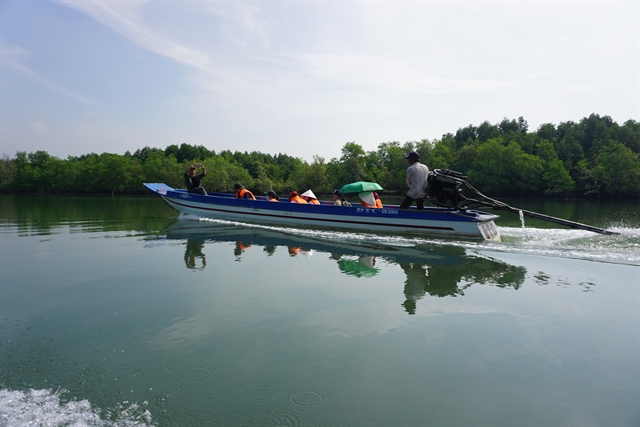
Visitors board a boat to explore Thiềng Liềng Island. — VNS Photo Thu Hằng
Lê Trương Hoàng Nam, a young man from HCM City, said: “My first impression as visiting Cần Giờ is untouched nature, an unpolluted environment, and peacefulness, which cannot be found in the city. The friendliness and warm hospitality of the locals also impress me. This place is a great escape from stressful city life."
"Delicious dishes made with fresh seafood, locally grown vegetables and herbs, served with fish sauce or chilli salt, make perfect meals for visitors," he said.
Nguyễn Thị Ánh Hoa, deputy director of HCM City's Department of Tourism, said: "The coastal district of Cần Giờ with its forest and sea ecosystem played a vital role in the city’s tourism development."
"The peaceful Thiềng Liềng Island, not far from the bustling economic hub of HCM City, makes it a special place to visit," she added.
In recent years, community-based tourism has been developed, offering unique experiences about local life and culture, she said.
Several households have invested in home-stay services to serve overnight visitors over the past year. They have received training in tourism-related services such as accommodation, transportation, and dining and entertainment services.
Wildlife sanctuary
The mangroves in Cần Giờ have a high biodiversity with more than 200 species of fauna and 52 species of flora, according to UNESCO.
A variety of wildlife such as bats, birds, saltwater crocodiles and macaques are found at the Vàm Sát Ecological Park, a section of the Mangrove Biosphere Reserve.
The 600-hectare Vàm Sát natural bird sanctuary is home to 70,000 birds of 26 different species. Visitors can observe thousands of birds flying around during the nesting season from April to October.
At Vàm Sát, tourists can also board rowing boats to explore the bat swamps where fruit bats nest.
The breeding season for the bat is in the 11th lunar month when thousands of bats hold their children against their chests in their nests.
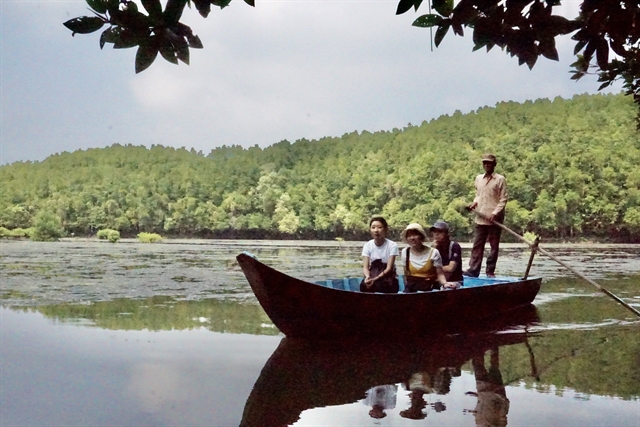
Visitors board a rowing boat to explore bat swamps where fruit bats nest. — VNS Photo Thu Hằng
The 26 metre-high tower at the centre of Vàm Sát is a prime place for visitors to observe the immense panorama of the forest and wildlife.
Jan Bordewijk, a tourist from Holland, said: “An eco-tour to Cần Giờ on a speedboat was nice. To me it was a bit like the Amazon area in Brazil. I saw a lot of mangroves, trees and big rivers. It's a pity we could not see some animals because it was not the best time of the year."
The Rừng Sác Guerrilla Base, Dần Xây Mangrove Park, Monkey Island, and the city-level architectural site Ông Thuỷ Tướng Temple (Temple worshipping the whale) are also appealing tourist attractions in Cần Giờ.
Seafood specialities
Wetland specialties such as crab, mudskipper, duck, mullet and oyster that grow naturally in mangroves make up most of the signature dishes of Cần Giờ.
Roasted crabs with tamarind sauce, grilled mudskippers with chili salt, sour eeltail catfish soup, and grilled oysters are must-try dishes for any foodie.
Dried shark catfish, bird's nest, and mango in Cần Giờ District are specialties that HCM City has given incentive policies for production, brand building and trade promotion.
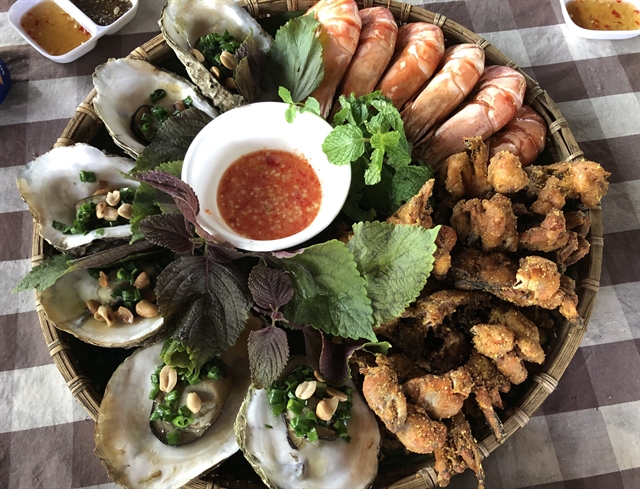
Delicious dishes made with fresh seafood, locally-grown vegetables and herbs, served with fish sauce or chilli salt, make perfect meals for visitors. — VNS Photo Thu Hằng
Cruise tourism
Ferries linking Cần Giờ District and Vũng Tàu City are scheduled to start in April, facilitating transport between the cities, according to the city's Department of Transport.
The ferry service with a capacity of 250 passengers, 100 motorbikes and 15 cars is expected to bring more tourists from Bà Rịa-Vũng Tàu Province to Cần Giờ District.
It takes three and a half hours to travel by car from Vũng Tàu City to Cần Giờ District, but only 30 minutes by ferry.
Phan Xuân Anh, chairman of Viet Excursions, said that passengers on cruise ships that dock at ports in Bà Rịa-Vũng Tàu Province preferred to take river tours to Cần Giờ for sightseeing instead of travelling for two hours by cars to visit the centre of HCM City.
“Cần Giờ should take advantage of river-based tourism because it could receive a huge number of cruise passengers from Bà Rịa-Vũng Tàu Province,” Anh said.
Over the last five years, the number of tourists visiting Cần Giờ District rose by 10 per cent each year, according to the district’s People’s Committee.
This year, the district welcomed 2.57 million visitor arrivals, up 29 per cent compared to last year.
The district’s tourism revenue is estimated at VNĐ1.4 trillion (US$60.51 million) this year, a year-on-year increase of 40 per cent. —VNS
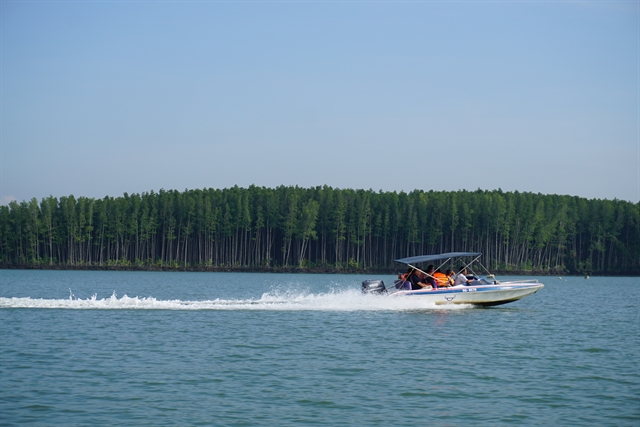
Boating is a great way to explore Cần Giờ. — VNS Photo Thu Hằng
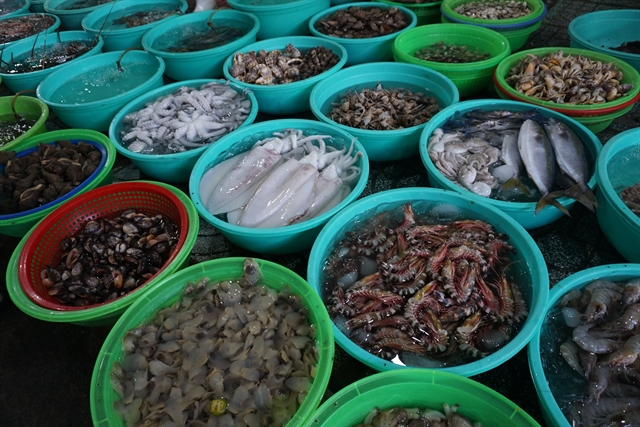
Fresh seafood is sold at Hàng Dương Market in Cần Giờ District. — VNS Photo Thu Hằng
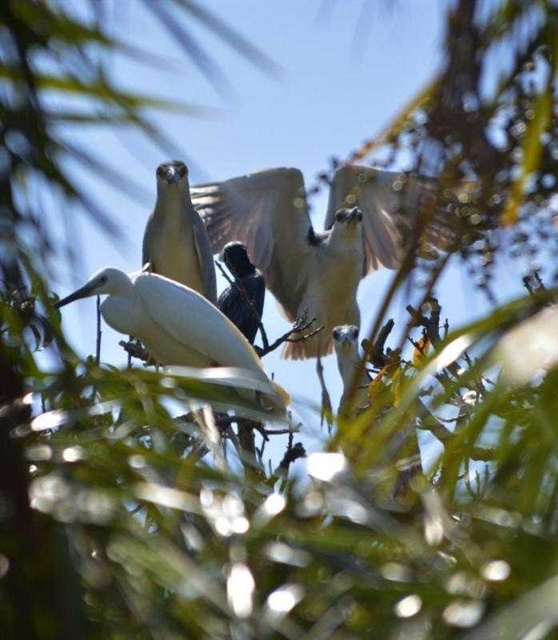
Vàm Sát natural bird sanctuary is home to 70,000 birds of 26 different species. — Photo courtesy of Vàm Sát Ecological Park